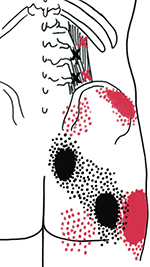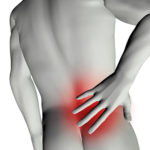 Chronic Low Back Pain – Quadratus Lumborum (QL) can cause debilitating pain. It is a factor in most chronic low back pain cases.
Chronic Low Back Pain – Quadratus Lumborum (QL) can cause debilitating pain. It is a factor in most chronic low back pain cases.
The pattern often radiates downward from the low back into the crest of the hip, sacrum, lower buttock and hip. It is typically worse on one side.
Pain may prevent turning over in bed and may disrupt sleep. You may be unable to bear the pain of standing upright or walking. Unloading the lumbar spine of upper body weight provides relief. Coughing or sneezing can be extremely painful.
This myofascial pain can be mistaken for the shooting pains of a spinal issue, sometimes referred to as sciatica.
Pain from QL trigger points can become significant when walking or running.
The first step in untangling any case of lower back pain is to confirm or eliminate more serious spinal injury or degeneration as a cause. Once this has been considered, we can focus on the soft tissue aspects of chronic lower back pain – quadratus lumborum is just one them.
The chronic low back pain quadratus lumborum stems from trigger points in the muscle.
These trigger points are activated by awkward sudden movements or an obvious sudden trauma such as an auto accident. They can also be activated by poorly controlled lifting of a large, awkward object or a quick stopping movement when the torso is twisted to one side. A similar version of this is angling sideways while bending forward to rise from a chair, couch, bed or car seat.
In addition, you can activate your QL by unusual, sustained or repetitive strain (microtrauma) such as gardening, housecleaning or long walks or runs on a crowned road. If you have a problem with your foot or ankle, you may receive a “boot” to immobilize it. This will suddenly increase your leg length and activate QL trigger points.
What Makes Low Back Pain From The QL Worse?
A soft mattress that sags in the middle aggravates tension in the QL in almost any sleeping position. There are many types of mattresses available; what you replace it with is a largely a matter of taste but we recommend a firm mattress.
The overload caused by the repetitive vigorous contractions of situps and improperly performed crunches can make the dysfunction of this muscle worse. Consider the eccentric contraction of Slow Sit-Backs or some of the many plank variations instead.
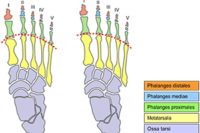 Most types of skeletal variations can also make myofascial dysfunction of the QL worse. This includes a pronated foot, a short leg, a small hemi-pelvis and shorter upper arms. A trained professional can evaluate these and offer simple inserts and other compensations for all of them. We may recommend Posture Control Insoles, heel lifts, ischial (butt) lifts and chairs with adjustable arm rests.
Most types of skeletal variations can also make myofascial dysfunction of the QL worse. This includes a pronated foot, a short leg, a small hemi-pelvis and shorter upper arms. A trained professional can evaluate these and offer simple inserts and other compensations for all of them. We may recommend Posture Control Insoles, heel lifts, ischial (butt) lifts and chairs with adjustable arm rests.
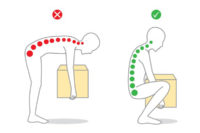 Everyone should avoid the combined movements of bending forward and sideways. You should be especially careful of this with QL trigger points. Turn the body to face the task squarely and lift safely from directly in front of you. Avoid stooping.
Everyone should avoid the combined movements of bending forward and sideways. You should be especially careful of this with QL trigger points. Turn the body to face the task squarely and lift safely from directly in front of you. Avoid stooping.
When playing with small children, gardening or performing other tasks low to the floor, attempt to either sit on the floor or sit on a low stool or step.
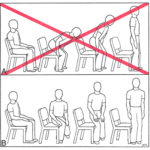 When sitting in a chair the Sit-Stand maneuver will avoid the unnecessary forward lean associated with getting up from sitting without the arms of a chair. You can vary this for use with a couch or auto seat.
When sitting in a chair the Sit-Stand maneuver will avoid the unnecessary forward lean associated with getting up from sitting without the arms of a chair. You can vary this for use with a couch or auto seat.
If you sleep on your back a pillow under the knees will provide gentle flexion at the hip and reduce stress on the quadratus lumborum. When sleeping on the side it is also important to keep a pillow between the knees and lower legs with the hips and knees just slightly flexed.
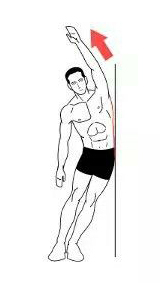 There are many types of side stretches that target the quadratus lumborum. Most patients find that passive side stretches against the wall is a good form of QL self-release. This will minimize the potential unsupported load and reduce excessive stretching. We also recommend using two tennis balls in sock, located between your waist and the wall, for self compression of the QL. You can also do a similar stretch sitting, crossed legged on the floor.
There are many types of side stretches that target the quadratus lumborum. Most patients find that passive side stretches against the wall is a good form of QL self-release. This will minimize the potential unsupported load and reduce excessive stretching. We also recommend using two tennis balls in sock, located between your waist and the wall, for self compression of the QL. You can also do a similar stretch sitting, crossed legged on the floor.
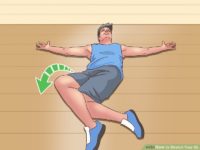 The are many ways to deepen this stretch or get to other fibers in the muscle by adding rotation and flexion. For example, this stretch done on the back provides some rotation. However, note that the motion is down from the knee, extending the QL on that side and contracting it on the other.
The are many ways to deepen this stretch or get to other fibers in the muscle by adding rotation and flexion. For example, this stretch done on the back provides some rotation. However, note that the motion is down from the knee, extending the QL on that side and contracting it on the other.
The ultimate yoga pose for stretching the QL is the triangle. The challenge with this is that many people have other restrictions in the chest, upper back, arms and hips. These get in the way of proper execution of triangle and the intended quadratus lumborum stretch.
There are also some QL stretches that can be done seated on the floor as in this nice video:
Structural Variation
Taut bands in the QL can mimic a variety of structural anatomical variations. For instance, the quadratus lumborum can pull up on one hip making it appear that the leg on that side is longer.
However, true structural variation happens and that can stress the QL. For example, some people have one of side of the hip that is smaller than the other side. This condition is known as a ‘small hemipelvis’ and can perpetuate a variety of myofascial syndromes. Differences in the size of the hip can be easily corrected with a small lift.
Functional Scoliosis
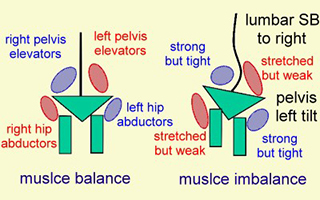 However, if the QL is merely creating the appearance of a structural problem, we would be on the wrong track. In this example diagram the “strong but tight” purple circle represents a QL with taut bands. The person on the right might like a heel lift at first, but they won’t need it once the muscle imbalance has been addressed.
However, if the QL is merely creating the appearance of a structural problem, we would be on the wrong track. In this example diagram the “strong but tight” purple circle represents a QL with taut bands. The person on the right might like a heel lift at first, but they won’t need it once the muscle imbalance has been addressed.
Quadratus lumborum is almost always a player in any case of scoliosis. Scoliosis is an abnormal curvature of the spine, also illustrated in this block diagram. Asymmetries in the action of the QL and other muscles can create a “functional scoliosis”. This can be corrected if treated before significant changes have occurred to the bony structure of the spine.
The Joker of Low Back Pain
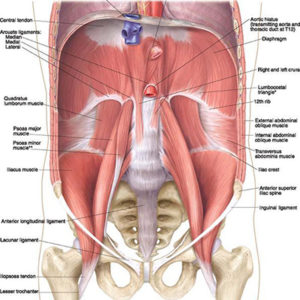 Quadratus lumborum is one of the most important postural muscles in the body. There are several sections to this muscle, responsible for varying pain patterns. QL is typically treated as a lower back muscle. In fact, the QL is the deepest abdominal muscle, lining the abdominal wall behind the digestive organs.
Quadratus lumborum is one of the most important postural muscles in the body. There are several sections to this muscle, responsible for varying pain patterns. QL is typically treated as a lower back muscle. In fact, the QL is the deepest abdominal muscle, lining the abdominal wall behind the digestive organs.
When standing, QL functions primarily as a “brake” against side flexion in the opposite direction.
It performs an eccentric, lengthening contraction when the spinal erectors and QL on the opposite side engage for side flexion. This means that it “pays out” gradually on the lengthening side against the contraction on the shortening side.
When sitting, the QL acts primarily for side flexion. When laying down, keeping the spine fixed, the QL elevates the hip on the contracted side. If your upper arms are shorter than average, you may also notice that the armrests of some chairs invite you to sit off to one side.
Engagement of both sides of the quadratus lumborum assists normal inhalation and exhalation by stabilizing the lower ribs.
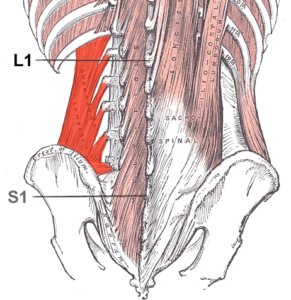 The quadratus lumborum muscle, informally called the QL, is a paired muscle of the left and right posterior abdominal wall. It is the deepest abdominal muscle, and commonly referred to as a back muscle. Each is irregular and quadrilateral in shape.
The quadratus lumborum muscle, informally called the QL, is a paired muscle of the left and right posterior abdominal wall. It is the deepest abdominal muscle, and commonly referred to as a back muscle. Each is irregular and quadrilateral in shape.
The quadratus lumborum muscles originate from the wings of the ilium; their insertions are on the transverse processes of the upper four lumbar vertebrae plus the lower posterior border of the twelfth rib. Contraction of one of the pair of muscles causes lateral flexion of the lumbar spine, elevation of the pelvis, or both. Contraction of both causes extension of the lumbar spine.
A disorder of the quadratus lumborum muscles is pain due to muscle fatigue from constant contraction due to prolonged sitting, such as at a computer or in a car. Kyphosis and weak gluteal muscles can also contribute to the likelihood of quadratus lumborum pain.
Structure
The quadratus lumborum muscle originates by aponeurotic fibers into the iliolumbar ligament and the internal lip of the iliac crest for about 5 centimetres (2.0 in). It inserts from the lower border of the last rib for about half its length and by four small tendons from the apices of the transverse processes of the upper four lumbar vertebrae.
The number of attachments to the vertebræ, and the extent of its attachment to the last rib, may vary. Also, occasionally, a second portion of this muscle is found in front of the preceding. It arises from the upper borders of the transverse processes of the lower three or four lumbar vertebræ, and is inserted into the lower margin of the last rib.
Relationships
-
Cross-section of the posterior abdominal wall, showing on the right the relationship of the quadratus lumborum muscle to the psoas major and sacrospinalis muscles.
-
Posterior view showing on the left the relationship of the left kidney to the left quadratus lumborum muscle.
Anterior to the quadratus lumborum are the colon, the kidney, the psoas major muscle, (if present) the psoas minor muscle, and the diaphragm; between the fascia and the muscle are the twelfth thoracic, ilioinguinal, and iliohypogastric nerves. The quadratus lumborum muscle is a continuation of transverse abdominal muscle.
Putting the Pieces Together
As mentioned above, in most cases of chronic low back pain – quadratus lumborum dysfunction rarely occurs in isolation. Trigger points in the QL often occur as part of a larger pattern of imbalance and myofascial dysfunction. Most of us are busy, so designing a program that will provide the most benefit with the least time and effort expended is important.
In addition, skeletal variations such as leg length differences, asymmetry in the pelvis or Morton’s foot structure can perpetuate dysfunction in the quadratus lumborum. A professional can help evaluate these factors and recommend simple corrective actions.
No one wants low back pain! We can work together with you to help sort out the issues.

